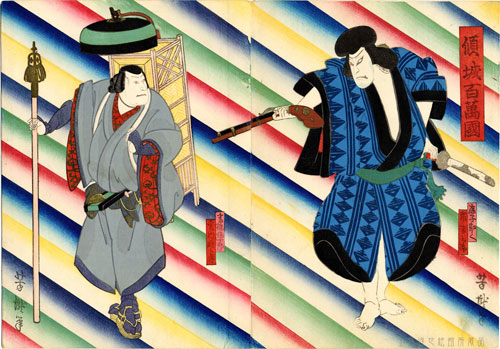Bokashi, a printmaking technique in Ukiyo-e
June 9 (Tue), 2015 – Sep. 6 (Sun), 2015
This museum mainly exhibits Ukiyo-e prints and paintings produced in Osaka in the Edo period. Most Ukiyo-e paintings made in Osaka were of portraits of actors playing kabuki in theatres. Made nearly 150-200 years ago, some of the Ukiyo-e prints and paintings still keep their colors clearly, showing us what the kabuki plays were like in those days.
Gorgeous stages depicted in Ukiyo-e are expressed using colors. These colors are printed on a sheet of paper by skillful printers. Not only the skills to produce precise carved woodblocks are excellent, but also the skills to print colors to the smallest details are the basis of colorfulness of Ukiyo-e.
In this feature exhibition, we focus on bokashi, a technique of Ukiyo-e printmaking, among other expressions of colors. Using this technique the artists express the shadows and the nature, like the sky and the sea, gradating each color, increasing colorfulness of Ukiyo-e. Enjoy variety of expressions using the bokashi technique.
 By Yoshitaki, Keisei Hyakumangoku
By Yoshitaki, Keisei Hyakumangoku
Bokashi technique
Bokashi is a technique in Ukiyo-e printmaking that makes colors gradually change from dark to light. Except using an ita bokashi technique, the gradation is created manually. There are several kinds of bokashi technique as introduced below.
Fuki bokashi is a technique that you dip a soaked-with-water brush in a paint and put it on a wetted woodblock, thus letting a paint naturally spread, creating darkness and lightness of a color.
Ichimoji bokashi is similar to fuki bokashi. It is a technique that a paint is applied along the top side of the woodblock, and the paint goes down gradating a color from dark to light. Atenashi bokashi is used to express things that are shapeless like fogs and clouds, therefore the results are inconsistent from print to print.
Ita bokashi is the way of shading off the border line of colors by shaving the edges of woodblock’s colored area slantwise. Ita bokashi creates slightly fuzzy gradation of colors rather than smooth gradation. Enjoy comparing these techniques of bokashi.
Effect of bokashi
Ukiyo-e paintings are produced by printing one color after another on a sheet of paper. As each color needs its own carved woodblock, the number of colors cannot be very large. By using the bokashi technique, however, each color gradates and thus enriches the colorfulness.
Bokashi also gives to the scene the depth that cannot be expressed by simple printing. When expressing nature in particular, like height of the sky or the limpidness of water, bokashi increases solidity. In addition, a world in which portrayed actors stand extends infinitely by using a bokashi technique.
Even if the background scenery isn’t fully drawn, bokashi expressions that are being used near the bottom of the picture to express the ground on which actors stand gives a sense of stability.
Here please enjoy the rich expressions of colors in Ukiyo-e created by bokashi.
Bokash embellishment
Bokashi not only expresses the depth of nature, but also increases gorgeousness. As bokashi is the technique that makes one color gradate from dark to light, it was the effective embellishment in Ukiyo-e, as the number of colors are limited.
Bokashi is also used to design patterns for clothes to increase the colorfulness. Yuzen-zome dyeing method, established around the Genroku era (1688-1704), made it possible to freely design patterns of clothes. By using bokashi dyeing method, beautiful gradation is delicately put on clothes. Bokashi printing technique reflects designability of these clothes. Through it, we can catch a glimpse of the fashion in those days.
See the excellent designability at the time that bokashi expresses.